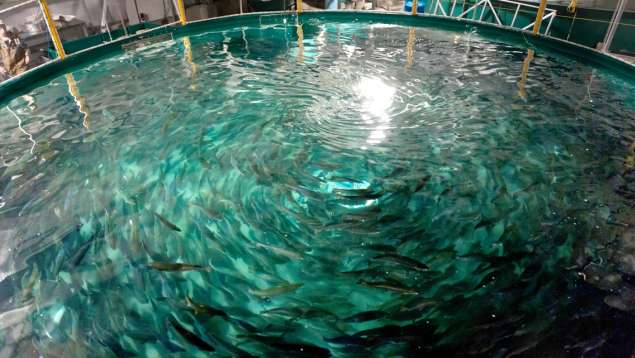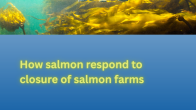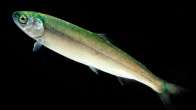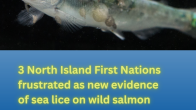Land-based Aquaculture in Recirculating Aquaculture Systems


Here's how RAS technology works:
- It starts with Atlantic salmon smolts at 100 grams, and water from wells or from the ocean.
- The water is disinfected, using ultraviolet light or special filtration systems.
- Fish are fed a feed with very little wild fish content. It is possible to purchase feeds today with zero wild fish content.
- The fish produce solid waste, which is removed with drum filters that screen out the solids.
- The fish give off CO2, which is removed by blowing air through the recirculating water. This drives off CO2 and vents it outside.
- The fish produce ammonia, which is harmful. It's removed by biofilters (biological filters), which are large colonies of two species of bacteria living on grains of sand or on plastic media that is suspended in water. The bacteria convert the ammonia to nitrate which is a safe substance.
- A small amount of new water is brought in on each cycle. As you see, the same amount in and out. It's as little as a fraction of a percent of the total volume on each cycle of water.
- Oxygen is added to the water just before it returns to the tanks.
Fish culture tanks come in various shapes and sizes, with round tanks being the most common shape in use currently. Important design criteria:
- maximum fish density
- optimum water velocity and hydraulics
- capability of settling suspended particles
Mechanical filtration devices screen out suspended particles (e.g. fish feces and feed particles) and are usually self-cleaning. Important design criteria:
- screen size
- maximum flow requirements
Biofilters remove toxic ammonia excreted by fish by converting it to less toxic nitrates. (They're also known as nitrification reactors.) There are a large number of approaches used to achieve this however, in aquaculture, they all use suspended or stationary media colonized with various types of bacteria. Important criteria:
- medium material and surface area
- management of bacterial film layer on the medium
- water quality control and total ammonia removal capacity of the biofilter
Gas exchange systems add oxygen and remove CO2 produced by fish. The first stage is aeration; water is disturbed to increase surface area, and airflow increases gas exchange between water and air. The goal and limit is to bring gas concentration into equilibrium with air (100% saturation). A second stage boosts oxygen concentration above 100% saturation to better meet fish needs. It involves mixing water and oxygen gas rather than air in a closed chamber. Important criteria:
- total gas exchange capacity
- energy efficiency
- oxygen transfer efficiency
Recirculating flow pumps move water through and between the RAS units, bring in the small inflow of new water and remove the equivalent small amount of discharge water. (Water is discharged to dilute some compounds that accumulate in the system, e.g. nitrates.) This requires moving high volumes of water with a low head. Important criteria:
- efficiency
- reliability
- redundancy
- rapid serviceability.
Myth-busting: Like all new technologies, recirculating aquaculture systems have evolved over time. Performance constraints in the industry only a few short years ago no longer apply, but it can be difficult to change perceptions built on past performance. Read the FAQ on land-based aquaculture here.






